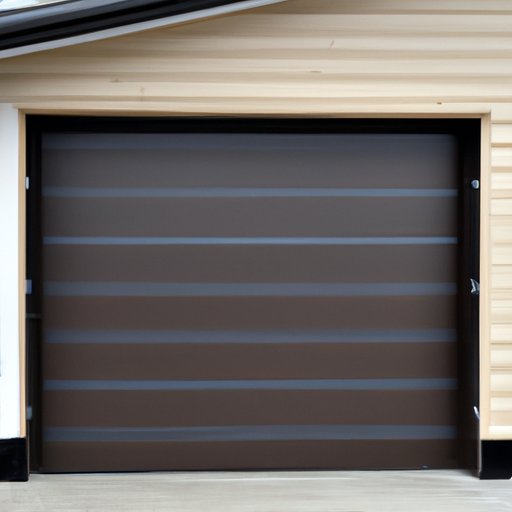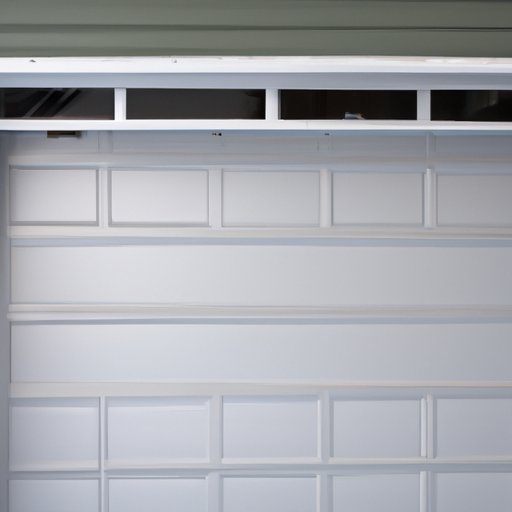
Introduction
If you are looking for a way to save money on energy bills and maintain a comfortable indoor temperature, insulating your garage door may be the solution. When not properly insulated, your garage door can be a major source of energy loss. In this article, we will explore the importance of insulating your garage door and provide step-by-step guidelines on how to do it yourself.
5 Simple Steps to Effectively Insulate Your Garage Door
Insulating your garage door is an easy task that you can do yourself. Here are the five steps to follow:
Step 1: Measure your garage door
You need to measure your garage door accurately to buy the right amount of insulation material. Measure the length and width of each panel, as well as the overall dimensions of the door. Take note of any windows, vents, or other obstacles that may affect the insulation process.
Step 2: Choose the insulation material
There is a wide variety of insulation materials available, including fiberglass, foam board, and reflective insulation. Consider the R-value (insulation efficiency) of each material and choose the one that best suits your needs and budget.
Step 3: Cut the insulation to size
Use a utility knife or scissors to cut your insulation material to fit the garage door panels accurately. Be precise when measuring and cutting, as even small gaps can reduce the insulation’s effectiveness.
Step 4: Attach the insulation to the garage door
Attach the insulation to the garage door using adhesive tape or glue. Use a sturdy adhesive that can withstand temperature changes and high humidity levels, if applicable. Be sure to cover the entire panel and secure the edges tightly.
Step 5: Check and do any necessary adjustments
Check your insulation periodically and make any necessary adjustments or repairs. Check for any gaps or uneven spots, and replace any damaged sections of insulation immediately.
A Complete Guide to Insulating Your Garage Door for All Seasons
Seasonal insulation is crucial when it comes to maintaining an optimal indoor temperature. Here is a complete guide to insulating your garage door throughout the year:
Importance of seasonal insulation
Your garage door insulation needs will vary depending on the season. In hot weather, you need insulation that reflects heat, while in cold weather, you need insulation that retains heat.
Best insulation materials for each season
For hot weather, reflective insulation material is best, as it reflects the sun’s rays and prevents heat from entering your garage. For cold weather, foam board insulation is best because it provides better insulation against cold temperatures.
Steps to insulate your garage door for each season
For hot weather insulation, you need to install reflective insulation material or radiant barrier foil on the garage door. For cold weather insulation, use foam board insulation panels on the garage door.
Tips to maintain your garage insulation all year round
Some tips to maintain your garage insulation throughout the year include inspecting your insulation regularly, repairing any damaged areas immediately, and cleaning the insulation periodically.
DIY: How to Insulate a Garage Door and Save Money on Your Energy Bills
Insulating a garage door yourself can save you a lot of money on energy bills. Here is a simple guide to insulating your door by yourself:
Benefits of DIY insulation
Some of the benefits of DIY insulation include saving money on hiring a professional, choosing the best insulation material for your needs, and understanding and maintaining your insulation better.
Materials and tools needed for insulation
You will need insulation material such as fiberglass or foam board, adhesive tape, a utility knife or scissors, and safety equipment such as gloves and a mask.
Step-by-step process of insulating your door by yourself
The process involves measuring your garage door, selecting insulation material, cutting insulation to size, attaching insulation to the garage door, checking for any gaps, and making any necessary repairs.
Money-saving tips
To save money, choose insulation material that is easy to install, buy in bulk to take advantage of discounts, and use leftover materials to insulate other areas of your home.
The Benefits of Insulating Your Garage Door and How to Do It Yourself
A well-insulated garage door can provide several benefits, including:
Advantages of insulating a garage door
Insulating your garage door can save you money on energy bills, improve your indoor comfort, reduce noise pollution, and protect your garage and its contents from extreme temperatures and weather conditions.
How insulation can improve energy efficiency
Insulation can prevent hot or cold air from escaping your garage, minimizing the amount of energy needed to maintain an optimal indoor temperature. This translates to lower energy bills and less strain on your HVAC system.
Various insulation materials to consider
Insulation materials include fiberglass, foam board, and reflective insulation, each with varying R-values, installation ease, price points, and other features.
Steps to insulating a garage door yourself
The steps involved in insulating a garage door are measuring the door, selecting insulation material, cutting insulation to size, attaching the insulation, and maintaining the insulation periodically.

Insulating Your Garage Door: The Essential Guide for Homeowners
Insulating a garage door is a vital task for homeowners looking to save money and maintain comfort levels. Here is an essential guide to insulating your garage door:
Importance of insulating your garage door
Uninsulated garage doors can cause energy loss, affecting your home’s heating and cooling efficiency. They can also lead to damaged garage contents, costly repairs, and pest infiltration.
Common types of garage door insulation materials
Common insulation materials include fiberglass, foam board, and reflective insulation material. Each offers varying benefits and drawbacks to insulation efficiency and cost-effectiveness.
Step-by-step guide to install insulation on your garage door
The steps involve measuring the door, selecting insulation material with an ideal R-value, cutting insulation to size, attaching the insulation with strong adhesive, and maintaining the insulation periodically.
Pros and cons of each type of insulation
Each insulation material may offer varying R-values, installation ease, and price points. It’s essential to consider each material’s pros and cons when selecting insulation for your garage door.
Expert Tips on Insulating Your Garage Door to Reduce Noise and Improve Comfort
Insulating your garage door can reduce noise pollution and improve comfort levels in your garage. Here are some expert tips to make it more effective:
How insulation can help reduce noise
Insulation materials can deter and absorb noise, reducing noise pollution generated by vehicles or other machinery in your garage.
Tips to make garage door insulation more effective
Some tips to make your garage door insulation more effective include choosing insulation materials with higher R-values, installing additional insulation panels, and repairing any damaged areas immediately.
Extra steps to make sure the insulation lasts longer
Extra steps, including properly securing the edges of the insulation, maintaining the insulation periodically, and using additional supporting panel materials like plywood, can make the insulation last longer.
Recommendations for reducing noise and improving comfort in the garage
Some recommendations include installing weather stripping, using noise-absorbing materials like rugs, insulating walls and ceiling, and minimizing clutter.
Conclusion
Insulating your garage door is an easy yet vital task for homeowners to minimize energy bills and maximize comfort levels. The benefits of a well-insulated garage door are numerous, and the steps to insulate one are simple. Make sure to follow the expert tips and maintain your insulation regularly for long-lasting effectiveness.





